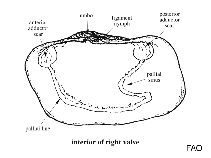Panomya norvegica (Spengler, 1793)
Arctic roughmyaتصوير گوگل | No image available for this species;
drawing shows typical species in Hiatellidae.
رده بندی / Names اسامي عام | مترادف | CoL | ITIS | WoRMS
Bivalvia | Adapedonta | Hiatellidae
Environment: milieu / climate zone / تغييرات عمق / distribution range بوم شناسي
; تغييرات عمق 4 - 500 m (مرجع 123431). Polar; 82°N - 33°N, 137°E - 36°E
Distribution كشورها | مناطق سازمان خوار و بار جهاني (FAO) | Ecosystems | ظهور | معرفي
Arctic, Northern Pacific, Northern Atlantic and the Mediterranean: from Japan to Arctic Alaska, south to California and east to Svalbard.
Length at first maturity / Size / Weight / سن
بلوغ: Lm ? range ? - ? cm Max length : 11.0 cm SHL جنس نر / بدون خواص جنسي; (مرجع 95344)
Life cycle and mating behavior بلوغ | تولید مثل | تخم ریزی | Eggs | Fecundity | Larvae
مآخذ اصلی
مراجع | هماهنگ كننده | همكاران
Templado, J. and R. Villanueva 2010 Checklist of Phylum Mollusca. pp. 148-198 In Coll, M., et al., 2010. The biodiversity of the Mediterranean Sea: estimates, patterns, and threats. PLoS ONE 5(8):36pp. (مرجع 85339)
وضعيت در فهرست قرمز IUCN
(مرجع 130435: Version 2025-1)
وضعيت از نظر سايتس (مرجع 108899)
CMS (مرجع 116361)
خطر برای انسان ها
استفاده انسانی
| FishSource |
ابزارها
اطلاعات بيشتر
تركيب غذايي
مصرف غذايي
شکارچیان
Max. ages / sizes
Length-weight rel.
Length-length rel.
نوسانات طولی
Mass conversion
فراواني
منابع اينترنتي
BHL | BOLD Systems | CISTI | DiscoverLife | FAO(Publication : search) | Fishipedia | GenBank (ژنوم, نوکلئوتيد) | GloBI | Gomexsi | Google Books | Google Scholar | Google | PubMed | Tree of Life | Wikipedia (برو, جستجو) | Zoological Record



